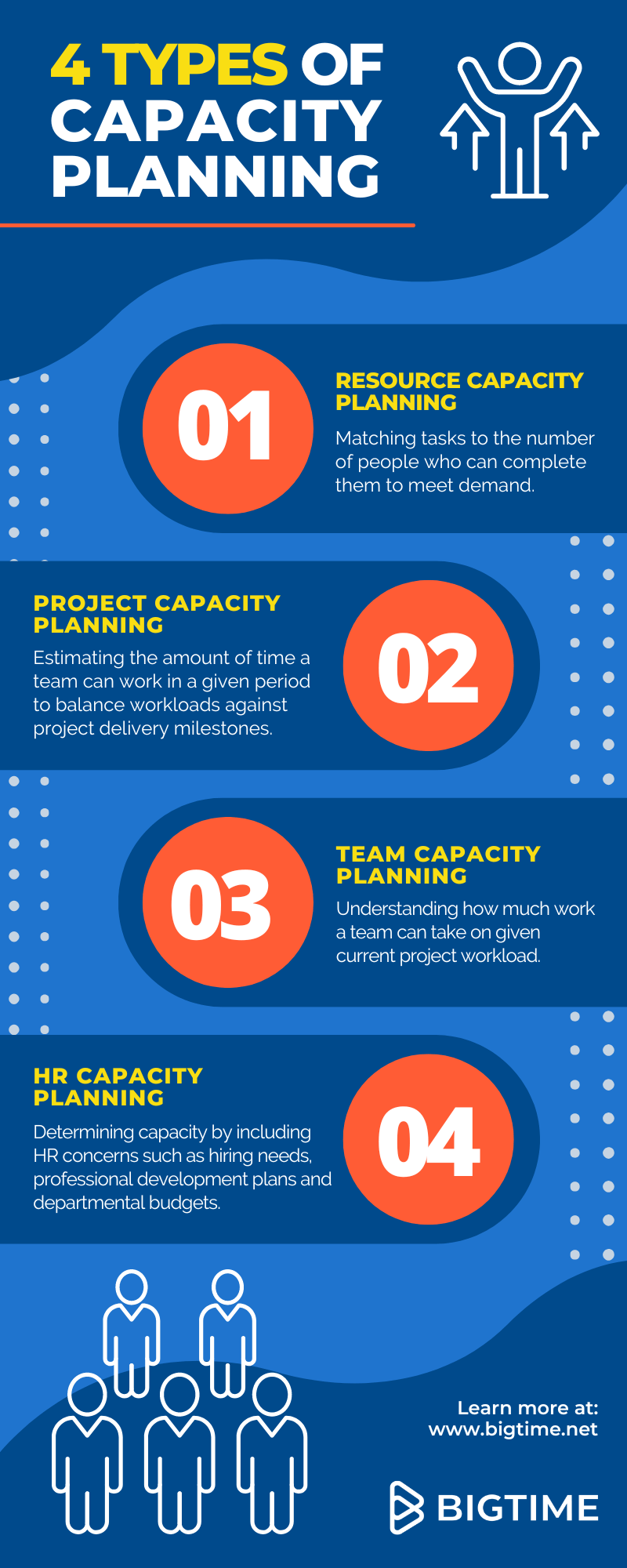
What is Capacity Planning in Operations Management?
Planning for supply and demand effectively is the basis of effective operational management and can increase delivery capacity, bring to light inefficiencies and mitigate risk. Ultimately, understanding and effectively managing capacity can mean the difference between a profitable business and one that is out of business.
In manufacturing, capacity planning in operations management involves understanding how many items can be produced in a given period based on materials and equipment available. Take a bakery, for example. Understanding how many pies can be made and baked in a given day using existing equipment and staff (capacity) allows the bakery to plan for how many pies they can sell and what they need for resources (staff, apples, etc.).
For project-based organizations that don’t have equipment, just people, capacity planning involves understanding the scope and timing of all current and planned work and the availability and skill-sets of the people who will do the work.
Services organizations and their project teams have a true challenge: trying to optimize their project staffing and resource management to generate as many billable hours as possible while avoiding burning out employees, delaying project delivery or missing revenue targets. Operating a services organization requires this balancing act take place on an ongoing basis, and means that capacity planning in operations management be done in several ways to truly achieve operational efficiency.
The 4 Types of Capacity Planning in Operations Management
There are several types of capacity planning in operations management that can inform your overall strategies. Four capacity planning types include:
- Resource capacity planning is the lifeblood of a services firm’s visibility into what work can be sold and delivered. Resource capacity at a high level is simply a calculation of number of employees multiplied by expected billable hours available in a given week. For most organizations, there has to be at least a few more considerations for optimal resource capacity planning, things like skill sets, utilization targets and work under management and in the sales pipeline create a complete understanding.
- Project capacity planning, by contrast, takes a view of a given project within an organization and the time and resources it needs. Project managers estimate the amount of time their assigned team can work in a given timeframe to balance workloads against project delivery milestones. Project capacity planning strategies need to be balanced with strong resource management, ensuring staff aren’t overworked (leading to burnout) or underworked (leading to lower profits).
- Team capacity planning is useful for groups that typically operate or work together. IT teams with specialized skills, for example, may perform work together on one or more projects. Project managers will use team capacity planning to understand how much work can get done from week to week and how those efforts will affect the project timeline.
- HR capacity planning is similar to resource planning but conducted by an HR group who may take into consideration other factors around professional development, ability to hire and onboard new staff and budget for new hires when determining capacity.
Capacity Planning Process
The most effective capacity planning process starts with these steps:
- Understand current capacity. What projects, using what people do we currently have under management? What extra time do people have to do more work?
- Project future demand. What projects are in our sales pipeline, how certain are they to close and when will they start. What skills will be required for those projects?
- Identify where additional capacity could come from. Can we work extra hours, develop new skills? Should we hire more people?
- Assess your risks. Will people burn out if we load in more work? What happens if we don’t meet demand? Calculate and quantify the risk of lower customer satisfaction if a project can’t start on time, or the cost of hiring and retraining employees if people quit. And don’t forget the lost opportunity costs associated with not having capacity to sell your services when demand is high.
Navigating Staffing Shortages With Smarter Capacity Planning
While the upsides to effective capacity planning in operations management include the ability to take on more projects, avoiding employee burnout and better customer service in a tight labor market it can make or break a company.
Considering that trends in staffing continue to point to fewer skilled workers available and increasing demand for their services, it is critical that companies are proactive about understanding their upcoming labor needs. Visibility into capacity translates to more time to plan for spending wisely, whether that means upskilling current staff and/or hiring contractors or full-time employees.
Capacity Planning Tools and How to Get Started
The proper capacity planning tools required depend on the size and maturity of your organization. Smaller organizations will likely get by with time reports, project plans and CRM data to understand when they can take on more work and or staff.
As your company grows, however, the need to become more operationally efficient rises and data management and processes become more important. Capacity planning software is necessary to manage more complex forecasting that relies on many data sets throughout the organization. That’s when most firms turn to a PSA tool.
PSA software provides visibility into continual long-term, medium-term and short-term capacity planning in operations management. This functionality allows for operational agility and optimized staffing and utilization.
This type of capacity planning software is used to create a roadmap for everyone in the organization, from project managers to resource managers to high-level executives. The right PSA for your organization will be the one that allows you to scale your business efficiently, taking advantage of demand while controlling for operational costs.
Where to Get Help With Capacity Planning in Operations Management
Ready to get more help for your capacity planning? Consider downloading our white paper, Capacity Planning for Scalable Growth. Or read our post on resource capacity planning for better customer service. And as always, reach out at any time if you’d like to see a demo of BigTime Software, the leading PSA software used by customers worldwide to scale and grow their services business.

Frequently Asked Questions About Capacity Planning in Operations Management
What is capacity planning for operations management?
Capacity planning in operations management is the process of balancing demand for a good or service with the ability of a manufacturer or organization to produce enough to meet demand.
What is capacity planning for professional services?
For project-based or professional services organizations, capacity planning, or service capacity planning, involves understanding the scope and timing of all current and planned work and the availability and skill-sets of the people who will do the work.
What are the four steps of capacity planning?
The four steps for capacity planning are:
1. Understand current capacity.
2. Project future demand.
3. Identify where additional capacity could come from.
4. Assess your risks.
Why is capacity planning important in operations management?
The goal of effective capacity planning in operations management is improved and more efficient business operations. Capacity planning allows businesses to optimize project staffing and resource management to generate as many billable hours as possible while avoiding burning out employees, delaying project delivery or missing revenue targets.
What are types of capacity planning in operations management?
Four capacity planning types include:
1. Resource capacity planning – Resource capacity planning at a high level is simply a calculation of number of employees multiplied by expected billable hours available in a given week.
2. Project capacity planning – Project managers estimate the amount of time their assigned team can work in a given timeframe to balance workloads against project delivery milestones.
3. Team capacity planning – This type is useful for groups that typically operate or work together. Tracking and forecasting at a team level is useful for project managers to take a “whole person” look at the group.
4. HR capacity planning – This is similar to resource planning but conducted by an HR group who may take into consideration other factors around professional development, ability to hire and onboard new staff and budget for new hires when determining capacity.
What are capacity planning tools?
The proper tools for capacity planning in operations management depend on the size and maturity of your organization. Smaller organizations will likely get by with time reports, project plans and CRM data to understand when they can take on more work and or staff. As a company grows, however, capacity planning software is necessary to manage more complex forecasting that relies on many data sets throughout the organization. That’s when most firms turn to PSA software.
What is resource capacity planning?
Resource capacity planning provides services firms with visibility into the amount of work that can be sold and delivered to meet customer demand. Resource capacity at a high level is simply a calculation of number of employees multiplied by expected billable hours available in a given week.
What is capacity planning process?
Capacity planning is the process of balancing demand for professional services with the resources and skills necessary to meet customer demand.
What is capacity in operations management?
The term capacity in operations management refers to the highest level of goods or services that a company can produce to meet demand.
What is project capacity planning?
Project capacity planning is the process of project managers estimating the amount of time their assigned team can work in a given timeframe to balance workloads against project delivery milestones.







